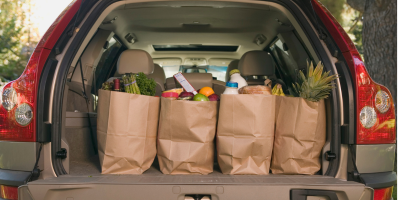I know, I know. You’ve been waiting for this moment. You gathered your income, sorted through your expenses, argued about debt with your spouse, got a little bummed when you realized how little you have in savings, but you have those goals and you can’t wait to get that budget put together and actually achieve them.
Today is your day!
Budget Tools
There are a couple of different ways individuals set up their budgets. If you’ve read any of my Real-Life Family Finance Features, you’ll notice that everyone does it just a little bit differently. Honestly, there’s really no wrong way to do it (except not to do it at all).
Paper and Pencil
This is the simplest way to track expenses for many people. It’s definitely not my preferred method, mostly because I don’t want to be hauling around my budget all of the time, but it is one that works for some.
In fact, I created polls on both Facebook and Twitter to ask my followers which they prefer and was stunned at the number of people that pick the paper and pencil method. One of the comments mentioned that it made it “more deliberate to erase and reallocate funds”.
If you’d like to get away from a simple notebook, why not check out the Blessed Budget Planner and see if it’s the right fit for you? Not only does it walk you through this entire process, but it allows you to consider savings and debt payoff methods you might not otherwise think about.
Excel Worksheet
Using an Excel Worksheet is another method of keeping track of bills. In fact, it’s the method my husband and I used for nearly ten years, and it worked pretty well for us. I personally like this method, because I don’t have to physically erase my work, but can add/move funds and categories as needed.
Online/App
Online budget trackers and apps are also gaining traction in the personal finance world, although, based on the poll I took, it doesn’t seem to be as popular as I envisioned it to be. Of course, if you find an online budget tracker to be helpful, by all means, use what works for you!
A Combination
Of course, there are a lot of people that use a combination of paper and pencil, Excel, and online apps, so you can pick and choose as you see fit. Don’t worry. If you are new to budgeting or interested in trying out a new method, it will be easy to transfer what we do today.
Putting that Budget Together
To start with, we are going to take the information we’ve accumulated over the past few installments: expenses, income, debt, and savings, and plug them into a paper version of a budget. In this case, I’ll be using the Family Budget Template, but you can use whatever method works best for you. (Find the template HERE.)
Goals
The whole reason you started this budget was that you have a goal you want to meet, correct? Add those goals (or even a single goal you intend to focus on) to the goals box at the top of the page. This will keep you thinking about why you are working on this process, to begin with!
Income
Based on the Income Worksheet you filled out, go ahead and enter the source of the income you will receive and your estimated amount. When you actually receive that income, you’ll fill in the “received” column.
Giving
Have a plan to give this month, whether it be to your church or a charity? If so, fill in that information.
Fixed Expenses
Remember that Fixed Expense Worksheet you filled out? Now is the time to put it to good use. Add all of the corresponding information into the Transportation, Housing, Tax, Lifestyle, and Insurance categories.
If you know the exact due dates, make sure to include those as well. There’s nothing like a late fee to ruin a perfectly decent budget.
Grocery
I set up the Grocery section of this worksheet in a weekly manner. As there are sometimes five weeks in a month, I added another line for you to fill in if you need it. I, personally, only budget with four weeks and if there is a slightly longer month, we use the extra days to clean out whatever is left in the fridge and the cupboards.
Of course, your budget has to work for your family, so do whatever you know you can stick with.
Household
I’ve incorporated a Household line for things such as paper towels, cleaning products, etc. Typically, these are things that you will purchase at the grocery store along with your food, but they should not be categorized as food.
Eating Out
Based on your estimation, make sure to include your eating-out expenses on the appropriate line. Don’t worry, you can always adjust it as needed based on your income to expense ratio.
Variable Expenses
Remember those Variable Expense Funds you put together? Add them here. Keep in mind that these “funds” are for expenses that come up over the course of your yearly budget and are not considered “savings funds” (we will incorporate those later).
I added a few to get you started.
Debt
The dreaded debt. If you don’t have any – you can skip over this section. Otherwise, look back at the Debt Worksheet we filled out and input the corresponding information into this section. If you plan to pay more than the minimum amount each month, then enter that in the “planned” column, otherwise, you can simply list the minimum payment.
Emergency Fund
I left you two lines here in case you have two separate emergency funds for one reason or another. If you don’t, just leave one of the lines blank. Make sure to input the starting balance of your emergency fund on the appropriate line.
If you have to use any money from the emergency fund, make sure to input that on the “withdrawn” line. Any money you “deposit” into that fund should be noted, and the ending balance calculated (Starting Balance minus amount withdrawn plus amount deposited equals ending balance). That ending balance from this month’s budget will be the starting balance for next month’s budget.
Other Funds
This is the section for those other savings funds including vacation, a large purchase, or whatever it is that might have been your dream for the future. It works exactly the same way as the emergency fund section, with the ending balances carrying over to next month’s beginning balance.
Final Calculations
The final step in this process is to make sure your expenses were completely covered by your income. To do so, you need to add up the totals for each section. (HINT: every colored box below a section should be the sum of the column above it.) If you are doing a trial run for your monthly budget estimation, you can add up the “planned” column.
When you’ve completed that step, head to the bottom of the final page of the budget and enter your total income, total expenses, and total savings, by following the directions on the worksheet.
Remaining Money
To calculate the difference between your budgeted expenses and savings versus your income, you will need to subtract your total expenses and savings from that income.
We will pretend that I had $54 leftover at the end of the month (and noted in that box). While that’s a good thing because I spent less than my income, I need to put that money somewhere to bring that sum to $0. In order to do so, I’ll take time to look at my goal and then move that money either to pay off a debt, my emergency savings fund, or to one of my “other” funds.
On the flip side: if you find that your “remaining money” is actually a negative number, then you will need to find a way to make that number $0. Let’s pretend your budget currently reads -$24. You will need to find a way to cut $24 from your budget. If you are planning the month ahead, then it will be easier to decide where that money will come from.
Perhaps you will tighten down on your eating out budget, and simply subtract $24 from that category. Split over four weeks, that’s only $6 per week out of your grocery budget. Or maybe there is another area of your budget that won’t miss that $24.
Still having trouble? Check out my post When Expenses Exceed Income.
Whatever you decide to do, make sure that the final number comes down to $0. By giving each dollar a purpose, you’ll be less likely to overspend and more likely to actually achieve those goals.
You Did It!
If you followed all of the steps, by now you should be looking at a completed copy of a budget that will work for your family. If you’ve noticed that you spend more than you want to in one category or another, you can make adjustments at any time. You can also make this budget work in a spreadsheet or on an app if you desire.
On the other hand, if you find that you aren’t spending as much in any given category, then you can repurpose that money to one of your funds or help you pay off debt.
Remember those goals you worked so hard on? Look over them again and decide what you need to change in order to achieve them. Prioritize, and you’ll find that you can actually meet those goals!
Questions? Don’t hesitate to leave a comment below.
Additional Budgeting Resources:
How to Keep Your Budget AND Your Friendships, Too



